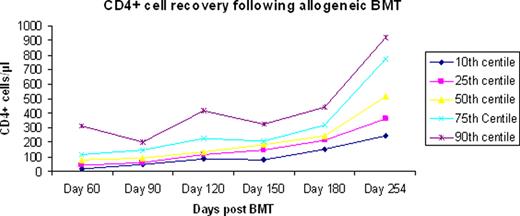Abstract
Abstract 2335
CMV viraemia and disease remains a major cause of morbidity and mortality following allogeneic bone marrow transplantation (BMT). We investigated the impact of low dose alemtuzumab conditioning in paediatric matched sibling allogeneic BMT for haemoglobinopathy on immune reconstitution (early and late CD3/4+, CD3/8+, CD3-/CD56+ cell recovery) and subsequent viral infections in 18 consecutive transplants (14 β thalassaemia major and 4 sickle cell anaemia). A secondary aim was to investigate the impact of immune reconstitution on graft versus host disease but due to the extremely low incidence of acute and chronic graft versus host disease with this protocol (acute grade II to IV 11.6% and chronic 4.6%) we were unable to assess this. Transplant protocol: following hypertransfusion to suppress endogenous haemopoiesis, patients were conditioned with oral busulfan 14 mg/kg (days -9 to -6), cyclophosphamide 200 mg/kg (days -5 to -2) and alemtuzumab 0.3 mg/kg (days -8 to -6). Graft versus host disease prophylaxis was provided with ciclosporin for six months and methotrexate 10 mg/m2 on days +4 and +7. All transplants used BM as source of stem cells. CMV PCR surveillance was undertaken twice weekly and CMV reactivation was treated with intravenous foscarnet or ganciclovir, followed by secondary prophylaxis with valganciclovir. Routine peripheral blood immunophenotyping of lymphocyte subsets was performed at 60-, 90-, 120-, 150- and 180- days post-BMT.
the median age of transplant recipients was 7 years (range 2 – 17 years) and median follow up 254 days (range 203–378). The median CD3/CD4+ cell count rose above 200 cells/μl by day 180 and above 300 cells/μl by day 254 following the withdrawal of immune suppression at six months (fig 1A), the median CD8+ cell count increased earlier, to >200 cells/μl by day 60 and 300 cells/μl by day 180 (fig 1B) and the median CD56+ cell count reached 200 cells/μl by day 60 and plateaued thereafter (fig 1C). Overall, CMV reactivation occurred in 13 patients (72.2%) after a median interval of 35 days following BM infusion (range day-1 to day +72): 10/13 patients (76.9%) in whom both recipient and donor were CMV positive (CMV +/+); 1/3 patients in whom recipient was CMV negative and donor CMV positive (CMV -/+); and in 1/1 who was CMV positive with a CMV negative donor (CMV +/−). Significantly there was no clinical CMV disease in any patient and with the use of oral valganciclovir there were no subsequent CMV reactivations. CMV reactivation occurred in patients with lower CD4+ cell counts at day 60 (67 cells/μl) compared with the CMV-unaffected group (a median CD4+ count 298 cells/μl; p= 0.0262). Four patients experienced other viral infections: HHV6 infection requiring foscarnet on day +85 (n=1), urinary BK virus not requiring treatment (n=2) and parainfluenza pneumonitis requiring ribavarin on day +12 (n=1).
Low dose alemtuzumab conditioning is associated with rapid CD4+ cell recovery (CD4+ >200 cells/μl by day +180) in children undergoing allogeneic matched related donor BMT for haemoglobinopathy. Although there is a high frequency of CMV reactivation (72.2%) in patients with low CD4+ counts at day 60 (median CD4+ count 67 cells/μl), no clinical CMV disease was seen and subsequent reactivations of CMV were prevented by the use of valganciclovir secondary prophylaxis whilst awaiting full immune reconstitution.
No relevant conflicts of interest to declare.
Author notes
Asterisk with author names denotes non-ASH members.




